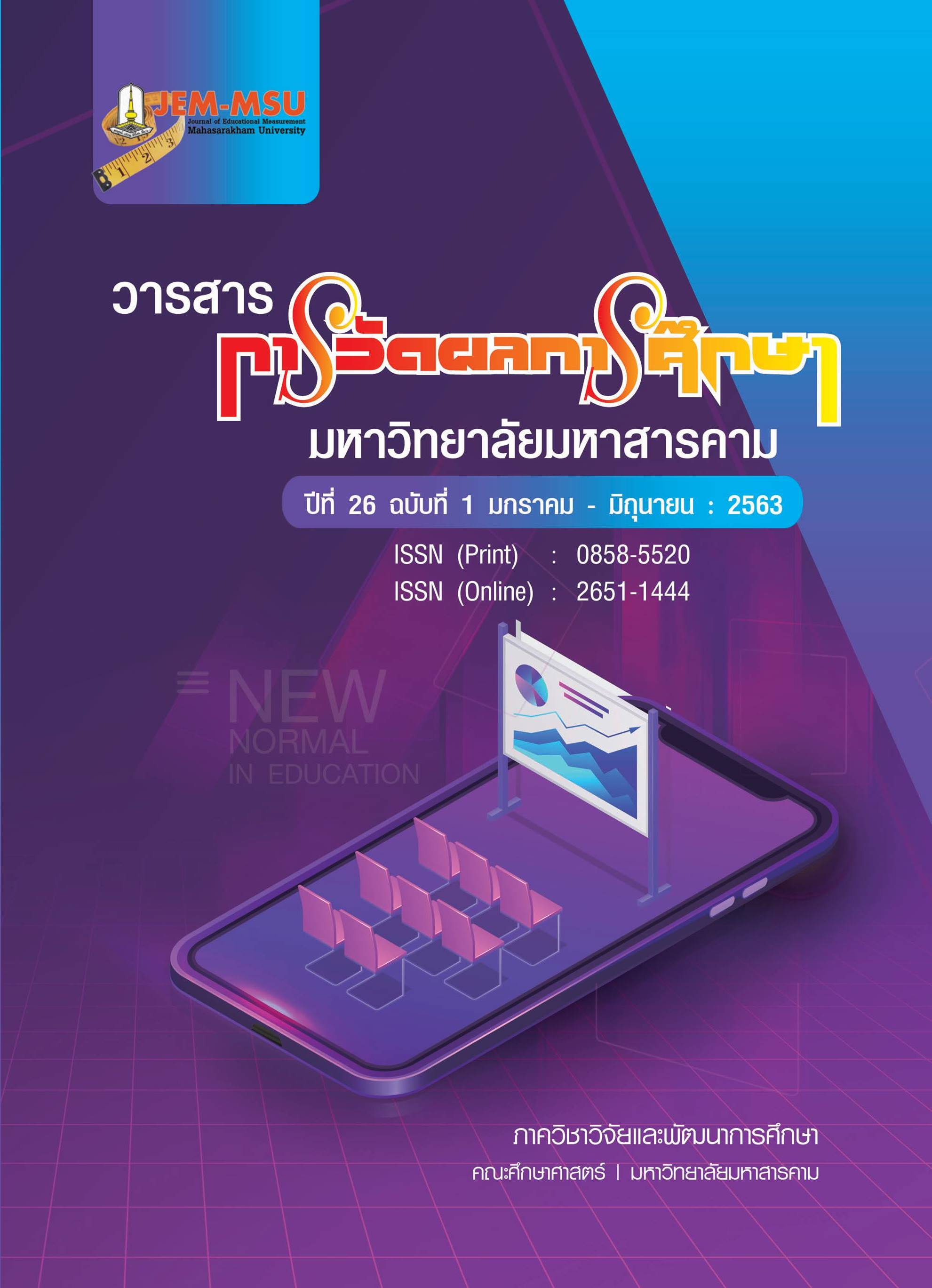Development of a Mathematical Reasoning Ability Test for Grade 11 Students in Kalasin Province
Main Article Content
Abstract
This research aimed to 1) construct a test on mathematical reasoning ability for grade 11 students, 2) find the quality of the test on mathematical reasoning ability for grade 11 students, and 3) create the norms of the test from the results of testing mathematical reasoning ability. The sample in this study consisted of 650 grade 11 students who were studying in the second semester of the academic year 2018 in 10 secondary schools in Kalasin Province, obtained through multi-stage random sampling. The research instrument in this study was a 4-choice test containing 75 items of which 45 were to be selected. The analysis of the quality of the test was to find the item difficulty, item discrimination, and total reliability. The norms were constructed in the form of normalized T-score which was expanded, using a predictive equation.
The results of this research were as follows:
1. The 75-item test on mathematical reasoning ability that was constructed consisted of 3 aspects of behavior- categorizing, relation analysis, and relation synthesis, having 25 items on each aspect.
2. The results of three times of giving the test were:
2.1 The first time revealed that the 75 question items had the difficulty ranged from 0.18 to 0.80 and the discrimination ranged from -0.03 to 0.66. There were 62 good items.
2.2 The second time revealed that the 60 question items had the difficulty ranged from 0.16 to 0.64 and the discrimination ranged from 0.11 to 0.84. There were 55 good items.
2.3 The third time revealed that 45 question items were composed of 15 question items on each of the three aspects, with the difficulty ranged from 0.34 to 0.80 and the discrimination ranged from 0.22 to 0.65. That means all of the items were identified as good and the total reliability was 0.87.
3. The norms of the 45-item mathematical reasoning ability test were obtained by converting the raw scores to normalized T-scores. The raw scores ranged from 7 to 42 and the normalized T-scores were between T13 and T68. The normalized T-scores were expanded into linear equation in order to cover every raw score. Thus Tc = 2.08 + 1.56X, and the first half normalized T-scores were expanded from 43 to 45, thus Tc ranged from T70 to T72, and the second half was expanded from 1 to 6, thus Tc ranged from T4 to T11.
In conclusion, when the raw scores that ranged from 1 to 45 were converted to normalized T-scores, they ranged from T4 to T72.
Article Details
The content and information contained in the published article in the Journal of Educational Measurement Mahasarakham University represent the opinions and responsibilities of the authors directly. The editorial board of the journal is not necessarily in agreement with or responsible for any of the content.
The articles, data, content, images, etc. that have been published in the Journal of Educational Measurement Mahasarakham University are copyrighted by the journal. If any individual or organization wishes to reproduce or perform any actions involving the entirety or any part of the content, they must obtain written permission from the Journal of Educational Measurement Mahasarakham University.
References
กรมวิชาการ. (2551). ตัวชี้วัดและสาระการเรียนรู้แกนกลาง กลุ่มสาระการเรียนรู้คณิตศาสตร์ตามหลักสูตร แกนกลางการศึกษาขั้นพื้นฐานพุทธศักราช 2551. กรุงเทพฯ : ชุมนุมสหกรณ์การเกษตรแห่งประเทศไทย.
ชวาล แพรัตกุล. (2520). เทคนิคการเขียนข้อสอบ. กรุงเทพฯ : โรงเรียนแพรัตอนุสรณ์.
ไตรรงค์ เจนการ. (2530). การศึกษาคุณภาพแบบทดสอบอัตนัยประยุกต์ เพื่อวัดความสามารถในการแก้ปัญหาคณิตศาสตร์. วิทยานิพนธ์ ค.ม. กรุงเทพฯ : จุฬาลงกรณ์มหาวิทยาลัย.
พวงรัตน์ ทวีรัตน์. (2540). การสร้างและพัฒนาแบบทดสอบผลสัมฤทธิ์. กรุงเทพฯ : สำนักทดสอบทางการศึกษาและจิตวิทยา มหาวิทยาลัยศรีนครินทรวิโรฒ.
ล้วน สายยศ และอังคณา สายยศ. (2539). เทคนิคการวัดผลการเรียนรู้. กรุงเทพฯ : สุวีริยสาส์น.
วิสุดา รักชู. (2547). การพัฒนาแบบทดสอบความสามารถในการให้เหตุผลทางคณิตศาสตร์สำหรับนักเรียนมัธยมศึกษาปีที่ 1 สังกัดสำนักงานการประถมศึกษาจังหวัดระนอง. วิทยานิพนธ์ กศ.ม. สงขลา : มหาวิทยาลัยทักษิณ.
ศิริชัย กาญจนวาสี. (2556). ทฤษฎีการทดสอบแบบดั้งเดิม. พิมพ์ครั้งที่ 7 กรุงเทพฯ: โรงพิมพ์แห่งจุฬาลงกรณ์ มหาวิทยาลัย.
สถาบันทดสอบทางการศึกษาแห่งชาติ (สทศ.). (2555). ค่าสถิติพื้นฐานของคะแนนโอเนต ระดับชั้น มัธยมศึกษา ปีที่ 6 ปีการศึกษา 2555. สถาบันทดสอบทางการศึกษาแห่งชาติ.
http://www.onetresult.niets.or.th/AnnouncementWeb/Login.aspx 10 กันยายน 2556.
สถานบันส่งเสริมการสอนวิทยาศาสตร์และเทคโนโลยี. (2552). คู่มือการจัดการเรียนรู้กลุ่มสาระการเรียนรู้ เพิ่มเติมคณิตศาสตร์ เล่ม 1 กลุ่มสาระการเรียนรู้คณิตศาสตร์. กรุงเทพฯ : โรงพิมพ์คุรุสภาลาดพร้าว.
สถานบันส่งเสริมการสอนวิทยาศาสตร์และเทคโนโลยี. (2550) ทักษะ/กระบวนการทางวิทยาศาสตร์. กรุงเทพฯ : โรงพิมพ์คุรุสภาลาดพร้าว.
สมนึก ภัททิยธนี. (2560). การวัดผลการศึกษา. พิมพ์ครั้งที่ 11. กาฬสินธุ์ : ประสานการพิมพ์.
สมนึก ภัททิยธนี. (2551) เทคนิคการสอนและรูปแบบการเขียนข้อสอบแบบเลือกตอบวิชาคณิตศาสตร์เบื้องต้น. พิมพ์ครั้งที่ 3. กาฬสินธุ์ : ประสานการพิมพ์.
สุนีย์ คล้ายนิล, ปรีชาญ เดชศรี และอัมพลิกา ประโมจนีย์. (2549). รายงานการประเมินผลการเรียนรู้จาก PISA 2003. กรุงเทพฯ : เซเว่นพริ๊นติ้ง.
สำนักงานรับรองมาตรฐานและประกันคุณภาพทางการศึกษา. (2547). มาตรฐานการศึกษา ตัวบ่งชี้และเกณฑ์ การพิจารณาเพื่อการประเมินคุณภาพภายนอก ระดับการศึกษาขั้นพื้นฐาน ฉบับปรับปรุง พ.ศ. 2547. กรุงเทพฯ : กลุ่มงานประเมินคุณภาพการศึกษาขั้นพื้นฐาน.
May and M. Eileen. (1975). “An Investigation of the Relationship of Moral and Cognitive Modes of Thought in Second and fifth Grade Children”, Dissertation Abstracts International, 36(1) : 192-A ; July.


